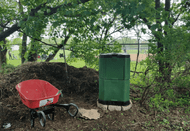Posted by by the Gubba Team
7th Apr 2022
Aerobin Composting Guide: how to use the Aerobin home composter

Considering an Aerobin, or maybe you’ve just invested? Great choice. The Aerobin is a fantastic way to divert your organic waste from landfill, and gives you rich, high-quality compost in return. Considering about 50% of the waste we create is organic, this is an effective, practical way to reduce greenhouse gas emissions - plus you’ll gain some amazing benefits in the process. Your garden will thank you!
The Aerobin really is a breakthrough in the home composting game. Its central ‘aeration lung’ breaks down organic waste through aerobic composting, and eliminates the need for manual intervention. No need to turn the compost heap anymore! It also features thermally insulated walls, allowing you to compost year-round. These walls retain heat generated by the composting process, and prevent cold air getting inside. The hot temperatures achieved in the Aerobin even allow you to compost pathogens and weeds, thanks to microbic bacteria.

To ensure your Aerobin is functioning at its best, there are a few things to keep in mind. Keeping the microbes in your compost happy requires a good supply of air, water, and a balanced diet (much like we do!). Read on for some tips for successful composting…
- First and foremost, the organic matter you put in your compost needs to be balanced. This results in more microbial activity, and therefore more efficient composting. The two key ingredients for healthy compost are both carbon-rich materials and nitrogen-rich materials. Carbon ingredients are commonly referred to as ‘brown’, as they include materials such as dried leaves, straw or cardboard. Nitrogen ingredients are often called ‘green’ as they include organic matter like fresh leaves, grass clippings and kitchen scraps. Note: although manure is brown in colour, it is actually a nitrogen-rich (green) material.
As a rule-of-thumb, your compost should be formed by mostly carbon-rich material. A fairly easy way to manage this is for each part of nitrogen-rich material you add, make sure you add about 4 times that volume of carbon-rich material (if you’re going by weight instead of volume, the general ratio is 30:1). If you’re just beginning some trial and error may be required, but you’ll be able to tell fairly easily if it needs adjusting - too much nitrogen and the biomass will be smelly and slimy; too much carbon and the biomass will be dry, have no smell, and take a long time to decompose. If the compost process is working well, it will have a fresh, earthy scent.
- Along with balancing your organic materials, you also need to regulate moisture content. Microbes require a moist environment - not too dry, and not too wet. When loaded into your Aerobin, the biomass should feel like a moist sponge.
- Breaking down your organic matter speeds up the composting process. Crush, break up or cut bulky items for efficient composting. Scrunch up or shred paper (don’t lay in sheets), and mulch green waste materials if possible. You can do this by running a lawn mower over it a few times.
- Mix up your organic waste, and layer it into the bin - 10-15cm layers work well, although this does depend on the composition of your specific ‘ingredients’.
- Keep in mind, the Aerobin is most efficient when it is loaded to at least 50% capacity.
- Your Aerobin also features a ‘leachate tank’ to collect the liquid nutrients dispelled as part of the composting process. You can use this liquid (also known as ‘worm wee’) as a natural fertiliser for the garden. Empty this tank as required, and dilute it 20:1 with water before using it on your plants.
 Getting started
Getting started
When starting out with your Aerobin, the first thing we recommend you do is load a 10cm layer of dried leaves or twigs into the bottom. This will prevent any blockages. Next, lay in some moist, active compost (this can be purchased from a garden centre to get you started) - this ensures you have a healthy amount of microbes, providing a good base for the composting process to begin. Lastly, start adding your ingredients and you’re away!
You can also visit the Aerobin Compost Simulator on the official Aerobin website. This feature allows you to simulate your compost using the specific ingredients/materials you have on hand, to ensure you achieve the ideal mix of carbon and nitrogen rich matter.
You can purchase a 200L or 400L Aerobin here.
Happy composting!


























